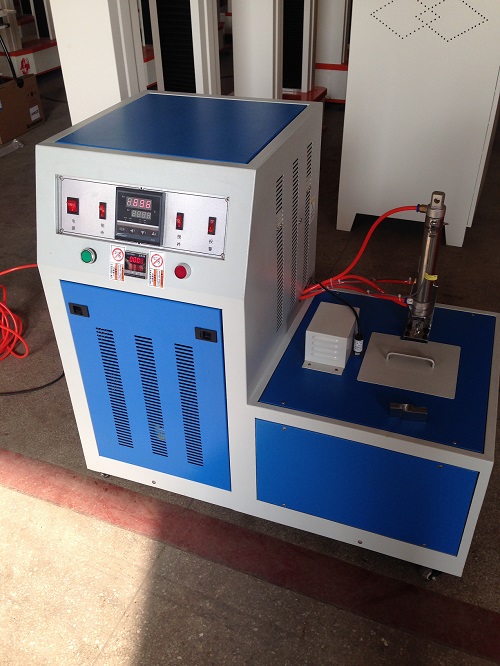
塑料冲击脆化温度试验仪 结构原理
A、本设备由制冷压缩机主机体、加热装置、电子控制箱、冷却槽、冷却介质循环系统、自动报警装置等部分组成。启动制冷开关后,压缩机开始工作,制冷系统进入正式工作状态。制冷压缩机连续不断的工作,当接近设定温度时,冷却槽中的加热装置开始按比例提供热量,用以平衡制冷系统产生的多余冷量,以达到恒温的目的。搅拌可使冷却槽内的冷却介质不断循环,使温度均匀一致。
B、试样夹持器
试样一边夹持4个试样(橡胶类),另一边夹持15个试样(塑料类)。
C、冲击装置
冲击装置由冲击锤和自锁机构组成。
D、冲击器
冲击头半径为1.6?0.1mm;
冲击时,冲击头和试样夹持器之间间隙为6.4?0.3mm;
冲击头的中心线与试样夹持器之间的距离为8?0.3mm。
塑料冲击脆化温度试验仪 仪器标准:
本仪器是根据GB1682国家标准设计的,各项技术指标符合HG 2-162-1965塑料低温冲击压缩试验方法和GB5470-2008 塑料冲击脆化温度试验方法等国家标准的要求。
适用行业:
可以用来考核和确定电工、电子、汽车电器、材料等产品,在低温环境条件下贮存和使用的适应性,适用于学校,工厂,军工,研位,等单位。
技术参数:
1.控温范围:室温-70℃(室温≤25℃)
2.恒温精度:?0.3℃
3.降温速度:0℃~﹣30℃ 约2.5℃/min
﹣30℃~﹣40℃ 约2.5℃/min
﹣40℃~﹣70℃ 约2.0℃/min
4.最大外形尺寸:900?500?800mm(长?宽?高)
5.工作室有效工作空间:280?170?120mm(长?宽?高)
6.可装试样数量:1
7.数字计时器数字计时器:0秒-99分钟,分辨率1秒
8.冷却介质:乙醇或其他不冻液
9.搅拌电机:8W
10.工作电源:220V--240V,50Hz,1.5kW
11.工作温度:≤25℃
组成
设备由工作台、升降夹持器、冲击装置、低温测温计、盛装冷冻介质的低温容器、搅拌器等部分组成。
升降夹持器
升降夹持器由夹持器和升降装置组成
从试样受冲击部位,到夹持器下端的距离为(11.0加或等于0.5)mm。
冲击装置
冲击装置由冲击器和冲击弹簧等组成。
冲击器
冲击器头部形状和尺寸,冲击器的质量为(200?20)g,其工作行程为(40?1)mm。冲击装置的弹簧在压缩状态下,冲击器端部到试样的距离为(25?1)mm。
低温测温计
采用最小分度不大于1度的低温测温计测量冷冻介质的温度,可使用低温温度计、热电偶、电阻温度计等。低温温度计为内标式半浸的,以尾长150MM,浸入液体深度75MM为宜。
冷冻介质
冷冻介质由适宜的传热介质加致冷剂调配而成。
传热介质
在试验温度下,能保持流动,对试样无附加影响的液体均可作传热介质。这类传热介质通常使用乙醇,此外还有丙酮、硅氧烷等。
致冷剂
可根据需要选用干冰或液氮。
注:也可采用其他降温方式。
试样规格:
试样的长度为(20.5?0.5)MM,宽度为(6.0?0.5)MM,厚度为(2.0?0.2)MM.
试样要求:
试验前,试样应放置在标准实验室温度下调节至少3H,并在明亮的光线下弯曲试样并检查试样表面,试样表面应光滑,无杂质、损伤及微孔。成品应经打磨后裁制成相应尺寸。
试验报告
A本标准名称或编号
B样品的详细说明及其来源
C使用的传热介质、致冷剂或其他降温方式
D程序A:脆性温度和试样破坏现象
E程序B:规定的试验温度和试验结果
试验结果与处理
程序A
1、试样出现破坏的最高温度,就是该试样的脆性温度。
2、温度值应精确到1度。
程序B
如果一组试样中没有任何1个试样破坏,则试验结果为无破坏。如果一组试样中有2个或2个以上试样发生破坏,则试验结果为破坏。如果一组试样中只有一个试样发生破坏,则再次取3个新的完好试样测试,3个试样均未发生破坏则试验结果为无破坏;否则试验结果为破坏。
使用方法
1接通电源,温控仪和计时器显示灯亮。
2向冷井中注入冷冻介质(一般为工业乙醇),其注入量应保证夹持器的下端到液面的距离为75?10mm。
3将试样垂直夹在夹持器上。夹的不宜过紧或过松,以防止试样变形或脱落。
4按下夹持器,开始冷冻试样,同时启动时序控制开关(或按动秒表)计时。试样冷冻时间规定为3.0?0.5min。试样冷冻期间,冷冻介质温度波动不得超过?1℃。
5提起升降夹持器,使冲击器在半秒钟内冲击试样。
6取下试样,将试样按冲击方向弯曲成180?,仔细观察有无破坏。
7试样经冲击后(每个试样只准冲击一次),如出现破坏时,应提高冷冻介质的温度,否则降低其温度,继续进行试验。 温度,如这两个结果相差不大于1℃时,即试验结束。
Structural Principles
A、 This equipment consists of a refrigeration compressor main body, a heating device, an electronic control box, a cooling tank, a cooling medium circulation system, an automatic alarm device, and other parts. After starting the refrigeration switch, the compressor starts working and the refrigeration system enters the official working state. The refrigeration compressor operates continuously, and as it approaches the set temperature, the heating device in the cooling tank begins to provide heat proportionally to balance the excess cooling generated by the refrigeration system and achieve constant temperature. Stirring can continuously circulate the cooling medium in the cooling tank, ensuring a uniform and consistent temperature.
B、 Sample holder
One side of the sample holds 4 samples (rubber type), and the other side holds 15 samples (plastic type).
C、 Impact device
The impact device consists of an impact hammer and a self-locking mechanism.
D、 Impactor
The radius of the impact head is 1.6 ? 0.1mm;
During impact, the gap between the impact head and the sample holder is 6.4 ? 0.3mm;
The distance between the centerline of the impact head and the specimen holder is 8 ? 0.3mm.
Instrument standards:
This instrument is designed according to the national standard GB1682, and all technical indicators comply with the requirements of national standards such as HG 2-162-1965 Low Temperature Impact Compression Test Method for Plastics and GB5470-2008 Plastic Impact Embrittlement Temperature Test Method.
Applicable industries:
It can be used to assess and determine the adaptability of products such as electricians, electronics, automotive appliances, materials, etc. to storage and use in low-temperature environmental conditions, suitable for schools, factories, military industries, research institutes, and other units.
Technical parameters:
1. Temperature control range: Room temperature -70 ℃ (Room temperature ≤ 25 ℃)
2. Constant temperature accuracy: ? 0.3 ℃
3. Cooling rate: 0 ℃~-30 ℃, about 2.5 ℃/min
-30 ℃~-40 ℃, about 2.5 ℃/min
-40 ℃~-70 ℃, about 2.0 ℃/min
4. Maximum external dimensions: 900 x 500 x 800mm (length x width x height)
5. Effective workspace of the studio: 280 x 170 x 120mm (length x width x height)
6. Number of samples that can be loaded: 1
7. Digital timer: 0-99 minutes, resolution of 1 second
8. Cooling medium: ethanol or other non freezing liquids
9. Mixing motor: 8W
10. Working power supply: 220V-240V, 50Hz, 1.5kW
11. Working temperature: ≤ 25 ℃
form
The equipment consists of a workbench, a lifting clamp, an impact device, a low-temperature thermometer, a low-temperature container for storing frozen media, a stirrer, and other parts.
Lifting gripper
The lifting gripper consists of a gripper and a lifting device
The distance from the impact area of the specimen to the lower end of the gripper is (11.0 plus or equal to 0.5) mm.
Impact device
The impact device consists of an impactor and an impact spring.
Impactor
The shape and size of the impactor head, the mass of the impactor is (200 ? 20) g, and its working stroke is (40 ? 1) mm. The spring of the impact device is in a compressed state, and the distance from the end of the impactor to the specimen is (25 ? 1) mm.
Low temperature thermometer
Using a low-temperature thermometer with a minimum division of no more than 1 degree to measure the temperature of the freezing medium, low-temperature thermometers, thermocouples, resistance thermometers, etc. can be used. The low-temperature thermometer is an internal standard semi immersed type, with a tail length of 150mm and a immersion depth of 75mm in the liquid.
Cryogenic medium
The freezing medium is composed of a suitable heat transfer medium and a refrigerant.
Heat transfer medium
At the test temperature, liquids that can maintain flow and have no additional impact on the sample can be used as heat transfer media. This type of heat transfer medium usually uses ethanol, in addition to acetone, siloxane, etc.
Refrigerant
Dry ice or liquid nitrogen can be selected as needed.
Note: Other cooling methods can also be used.
Usage
1. Connect the power, and the temperature controller and timer display lights will light up.
Inject refrigerant (usually industrial ethanol) into the cold well in two directions, and the injection amount should ensure that the distance from the lower end of the gripper to the liquid level is 75 ? 10mm.
3. Clamp the sample vertically onto the gripper. The clamping should not be too tight or too loose to prevent deformation or detachment of the sample.
4. Press the gripper to start freezing the sample, and at the same time, activate the timing control switch (or press the stopwatch) for timing. The freezing time of the sample is specified as 3.0 ? 0.5min. During the freezing period of the sample, the temperature fluctuation of the freezing medium shall not exceed ? 1 ℃.
Lift the lifting gripper and allow the impactor to impact the specimen within half a second.
6. Remove the sample, bend it 180 ? in the direction of impact, and carefully observe for any damage.
After 7 samples have been impacted (each sample is only allowed to be impacted once), if damage occurs, the temperature of the freezing medium should be raised; otherwise, the temperature should be lowered and the test should continue. When the temperature difference between these two results is no more than 1 ℃, the test is completed.
业务咨询:932174181 媒体合作:2279387437 24小时服务热线:15136468001 盘古机械网 - 全面、科学的机械行业免费发布信息网站 Copyright 2017 PGJXO.COM 豫ICP备12019803号